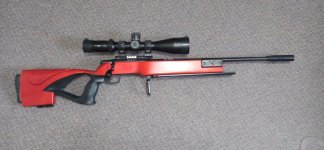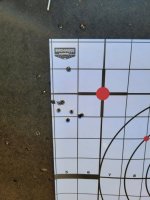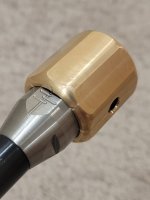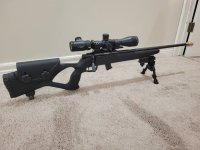There are guns that are "cheap" as in "inexpensive"...and there are guns that are "cheap" as in "cheaply made". This gun is both. 
There was a lot of discussion about the Scorpio .22 bolt gun awhile back; the short-barrel version was on sale pretty cheap at SFRC and other places, and since I like short guns I unbolted/unzipped/un-velcroed my wallet and ordered one. It came quickly, well packaged, good service overall from SFRC. When I opened up the box, I was taken aback by what an ugly little spud it was in person, even more so than it was in pics, but my next impression upon hefting it was "Wow...comfortable!" I'm one of those unfortunate souls who finds guns that look good are usually uncomfortable for me to shoulder and use, while many of the dogs fit me like a glove. This was one of the latter.
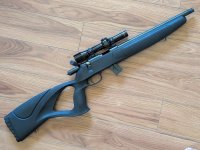
So, in no particular order, here are a few impressions and comments about this thing:
Good - As stated, I find the stock very comfortable to handle and hold. Stock fit is a very personal thing, YMMV obviously.
Bad - As stated...it's ugly with a capital Ugh! This might actually be a benefit in disguise. It looks so bad now that I may play around with painting the stock; can't make it any worse...
Indifferent - I have only the one magazine, and have used it for about 200 rounds so far. Bolt operation is neither smooth nor rough, and is already improving noticeably...which I suppose means it was pretty rough to start. Feeding is fairly good, but I've had maybe 4 or 5 fails to feed, with the bullet nose jamming against...not really sure, actually, it just jams at an angle with the bullet nose already entering the chamber. It seems to need a very firm and fast push to function 100%...you can't merely operate the bolt smartly, as many bolt guns require; you need to really ram it hard and fast, to the point where you worry that if one does still jam you will destroy the cartridge. Operated like that, it has never jammed, but needing to do it gorilla-style like that gets old. I'm hoping and assuming that this will improve with use. Extraction has been perfect; ejection is weak...the rounds just sort of fall almost straight down after barely jumping out of the receiver opening...but it has never failed. It isn't confidence-inspiring, but it makes cleaning up the brass mess afterwards very easy.
Indifferent - The trigger is not particularly heavy or light, maybe a couple pounds. It's a wee bit creepy, a wee bit spongy, and really gives you no warning that it's about to trip; not a 2-stage, maybe not even a 1-stage. It isn't horrible, but certainly not great.
Indifferent - Accuracy is okay. Some loads print an inch @ 50 yards, some closer to 1 or even 2 inches. I'm using only standard, hi-vel or standard stuff, no target-grade premium ammo. I have the gun sighted at 50yards and it is quite sufficient for backyard pest use, 50- and 100-yard gongs and spinners and other reactive targets.
Bad - The gun comes with a bulky and unattractive pic rail that attaches with three cross-bolts to the rimfire grooves cut into the top of the receiver. This rail extends back towards the shooter much farther than I need it to, but it doesn't extend far enough to the front for optimum support of larger, longer scopes. I have a long neck and tend to mount scopes further forward than many people, so this criticism might only apply to folks with a similar build. If you are one of the shooters who mount a scope with the eyepiece lens about halfway along the cheekpiece, you'll be fine.
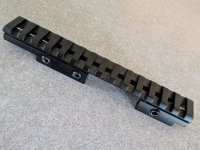
The rail is a single solid piece of aluminum, so when the cross-bolts are tightened they are actually flexing the structure of the unit to clamp on the grooves. This is similar to the well-known Burris Zee rings; everybody thinks they're great, but IMHO the idea of making the clamp out of a single rigid piece of metal and then trusting it to flex when the screws are tightened just reeks of "cheap"...both definitions of it. I can't help but think that this receiver...which I assume was always intended for a cheapie utility rifle...could have been made just as inexpensively, or even more so, by just machining the top flat in conjunction with the dovetails, or better still by drilling/tapping the top for some commonly-available Weaver base and foregoing the dovetails altogether. Either route would have been preferable to the one they chose.
But there's more about the optics mounting situation that ain't great. The top of the receiver is not flat, but rather strongly convex, so much so that it has three cross-grooves into which the three clamping screws for the mount must fit. This means the rail must go into that one fixed position. No sweat, I figured...I'll just ditch that big ugly contraption and use standard rimfire rings, right? Nope! The convex upper surface of the receiver prevents most rings of that type from being secured properly; most of them have a flat bottom profile and the receiver hump pushes them so far up that the clamps don't reach the receiver grooves. If you are lucky, or if you happen to have a drawerful of assorted bits'n'pieces of hardware at home, you might find a set of rings that work. In my case, this turned out to be a pair of Millett rimfire rings, whose bottom curvature perfectly matches the receiver top. I was able to mount a nice small Leupold fixed 2.5x compact scope much lower than the OEM rail would have allowed, and also to place it in exactly the correct eye-relief location for me to use.
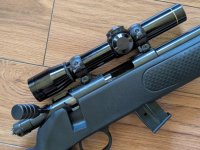
The Really Bad - Anyone who has done any amount of shooting with assorted guns over the years has likely encountered barrels and receivers which disagree about which way they should be pointing. In most cases this is not really noticeable unless you are looking specifically for it, and can usually be compensated for with the scope adjustments. This particular gun is the worst example of this I have ever seen; the barrel and receiver not only disagree, but they aren't even talking to each other. It's instantly visible when you sight down the top of the rifle. I spotted it when I mounted the scope in the Millett rings; these rings clamp from both sides, and so a considerable degree of windage adjustment can be had by tightening/loosening opposite sides of each ring. I had to use this on both rings, moving the front one right and the rear one left, which of course required some ring lapping to seat the scope smoothly without torque. Correctable? Yes, with some effort, but not a sign of quality.
The Good - This is what makes all the other crap less onerous and more easily acceptable: at the price these guns were selling for, you can not only forgive some glitches but in fact I tend to expect them. If you like tinkering, and derive some perverse joy out of trying to turn a sow's ear into a slight less offensive ear from a really nice sow, you might even enjoy the project.
My granddaughters like this gun, and I don't hate it, but...it'll probably stick around for awhile, if for no other reason than the fact that I have lapped the crap out of a pair of scope rings for it, making them useless for anything else. But it is a cool little gun, great for kids, acceptably accurate and functional. I like it, I guess...but I don't love it.
There was a lot of discussion about the Scorpio .22 bolt gun awhile back; the short-barrel version was on sale pretty cheap at SFRC and other places, and since I like short guns I unbolted/unzipped/un-velcroed my wallet and ordered one. It came quickly, well packaged, good service overall from SFRC. When I opened up the box, I was taken aback by what an ugly little spud it was in person, even more so than it was in pics, but my next impression upon hefting it was "Wow...comfortable!" I'm one of those unfortunate souls who finds guns that look good are usually uncomfortable for me to shoulder and use, while many of the dogs fit me like a glove. This was one of the latter.

So, in no particular order, here are a few impressions and comments about this thing:
Good - As stated, I find the stock very comfortable to handle and hold. Stock fit is a very personal thing, YMMV obviously.
Bad - As stated...it's ugly with a capital Ugh! This might actually be a benefit in disguise. It looks so bad now that I may play around with painting the stock; can't make it any worse...
Indifferent - I have only the one magazine, and have used it for about 200 rounds so far. Bolt operation is neither smooth nor rough, and is already improving noticeably...which I suppose means it was pretty rough to start. Feeding is fairly good, but I've had maybe 4 or 5 fails to feed, with the bullet nose jamming against...not really sure, actually, it just jams at an angle with the bullet nose already entering the chamber. It seems to need a very firm and fast push to function 100%...you can't merely operate the bolt smartly, as many bolt guns require; you need to really ram it hard and fast, to the point where you worry that if one does still jam you will destroy the cartridge. Operated like that, it has never jammed, but needing to do it gorilla-style like that gets old. I'm hoping and assuming that this will improve with use. Extraction has been perfect; ejection is weak...the rounds just sort of fall almost straight down after barely jumping out of the receiver opening...but it has never failed. It isn't confidence-inspiring, but it makes cleaning up the brass mess afterwards very easy.
Indifferent - The trigger is not particularly heavy or light, maybe a couple pounds. It's a wee bit creepy, a wee bit spongy, and really gives you no warning that it's about to trip; not a 2-stage, maybe not even a 1-stage. It isn't horrible, but certainly not great.
Indifferent - Accuracy is okay. Some loads print an inch @ 50 yards, some closer to 1 or even 2 inches. I'm using only standard, hi-vel or standard stuff, no target-grade premium ammo. I have the gun sighted at 50yards and it is quite sufficient for backyard pest use, 50- and 100-yard gongs and spinners and other reactive targets.
Bad - The gun comes with a bulky and unattractive pic rail that attaches with three cross-bolts to the rimfire grooves cut into the top of the receiver. This rail extends back towards the shooter much farther than I need it to, but it doesn't extend far enough to the front for optimum support of larger, longer scopes. I have a long neck and tend to mount scopes further forward than many people, so this criticism might only apply to folks with a similar build. If you are one of the shooters who mount a scope with the eyepiece lens about halfway along the cheekpiece, you'll be fine.

The rail is a single solid piece of aluminum, so when the cross-bolts are tightened they are actually flexing the structure of the unit to clamp on the grooves. This is similar to the well-known Burris Zee rings; everybody thinks they're great, but IMHO the idea of making the clamp out of a single rigid piece of metal and then trusting it to flex when the screws are tightened just reeks of "cheap"...both definitions of it. I can't help but think that this receiver...which I assume was always intended for a cheapie utility rifle...could have been made just as inexpensively, or even more so, by just machining the top flat in conjunction with the dovetails, or better still by drilling/tapping the top for some commonly-available Weaver base and foregoing the dovetails altogether. Either route would have been preferable to the one they chose.
But there's more about the optics mounting situation that ain't great. The top of the receiver is not flat, but rather strongly convex, so much so that it has three cross-grooves into which the three clamping screws for the mount must fit. This means the rail must go into that one fixed position. No sweat, I figured...I'll just ditch that big ugly contraption and use standard rimfire rings, right? Nope! The convex upper surface of the receiver prevents most rings of that type from being secured properly; most of them have a flat bottom profile and the receiver hump pushes them so far up that the clamps don't reach the receiver grooves. If you are lucky, or if you happen to have a drawerful of assorted bits'n'pieces of hardware at home, you might find a set of rings that work. In my case, this turned out to be a pair of Millett rimfire rings, whose bottom curvature perfectly matches the receiver top. I was able to mount a nice small Leupold fixed 2.5x compact scope much lower than the OEM rail would have allowed, and also to place it in exactly the correct eye-relief location for me to use.

The Really Bad - Anyone who has done any amount of shooting with assorted guns over the years has likely encountered barrels and receivers which disagree about which way they should be pointing. In most cases this is not really noticeable unless you are looking specifically for it, and can usually be compensated for with the scope adjustments. This particular gun is the worst example of this I have ever seen; the barrel and receiver not only disagree, but they aren't even talking to each other. It's instantly visible when you sight down the top of the rifle. I spotted it when I mounted the scope in the Millett rings; these rings clamp from both sides, and so a considerable degree of windage adjustment can be had by tightening/loosening opposite sides of each ring. I had to use this on both rings, moving the front one right and the rear one left, which of course required some ring lapping to seat the scope smoothly without torque. Correctable? Yes, with some effort, but not a sign of quality.
The Good - This is what makes all the other crap less onerous and more easily acceptable: at the price these guns were selling for, you can not only forgive some glitches but in fact I tend to expect them. If you like tinkering, and derive some perverse joy out of trying to turn a sow's ear into a slight less offensive ear from a really nice sow, you might even enjoy the project.
My granddaughters like this gun, and I don't hate it, but...it'll probably stick around for awhile, if for no other reason than the fact that I have lapped the crap out of a pair of scope rings for it, making them useless for anything else. But it is a cool little gun, great for kids, acceptably accurate and functional. I like it, I guess...but I don't love it.















































